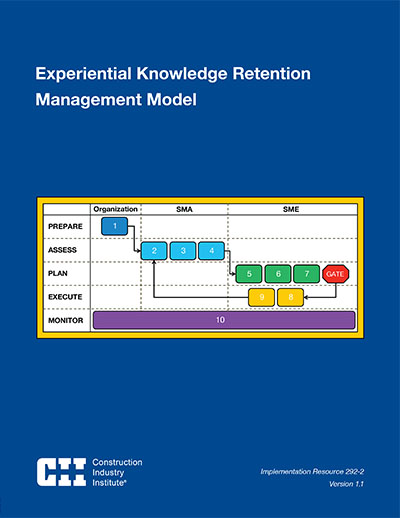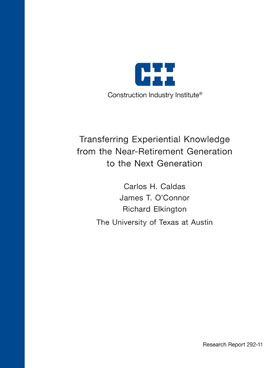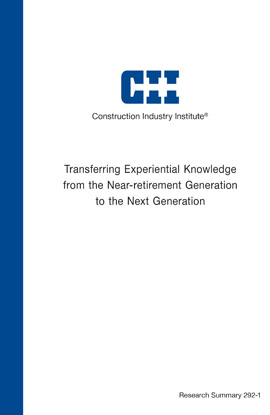
Experiential Knowledge Retention Management Model, Version 1.1
The capital projects industry is experiencing a dramatic increase in the rate of people leaving the workforce. As Baby Boomers reach the traditional retirement age of 65, an experiential knowledge deficit is developing that has the potential to seriously affect the operational capacity of many organizations. Experiential knowledge is defined as follows:
Knowledge that constitutes the insight, wisdom, and good judgment gained through experience; often characterized as “know-how;” typically developed more through “doing” than through other forms of learning.
The operational effects of an experiential knowledge deficit within an organization include a reduction in operational efficiency, an increase in the number of critical errors, an impaired ability to innovate, and a limitation on the pursuit of growth strategies. These effects have the potential to seriously affect an organization’s financial viability and longevity by increasing its operating costs and eliminating any competitive advantage it has. (Appendix B includes additional information on how the capital projects industry as a whole and the organizations within it are affected by this problem.)
Because research shows that, typically, mitigation of experiential knowledge loss is often reactive, and largely ineffective, CII Research Team 292 recommends a move toward a proactive model. The team urges highly experienced construction professionals and their managers to make experiential knowledge transfer a continuous process. Most importantly, this process should become an industry priority. Appendix C provides an overview of the methodology used by the research team to develop, refine, and validate the model, and more details can be found in Research Summary 292-1.)
The experiential knowledge transfer model developed by RT 292 and presented here helps organizations formulate their knowledge loss risk profiles. In addition to assessing impending experiential knowledge loss, the model offers strategies for mitigating the loss potential. Specifically, it allows organizations to effectively select the knowledge transfer strategies (KTSs) that are uniquely suited to the transfer conditions of their retirees and the younger employees being developed as the subject matter experts (SMEs) who will take their places. The team developed this model specifically to facilitate experiential knowledge transfer from individuals approaching retirement; it can, however, be adapted to suit a wider audience. It is important to recognize that the model proposes the implementation of an ongoing program; successful implementation requires proper training, continuous improvement, and customization to align it with each organization’s culture and needs.
This implementation resource begins with an overview of the model. Each subsequent chapter provides an in-depth look at each step of the model, and includes a description, motivation for pursuing the step, expected deliverables, a detailed look at sub-steps, and the tools required for each step. (The appendices of this document provide supporting information.)
The Knowledge Retention Management (KRM) model developed by RT-292 was designed to address the practical implications facing the capital projects industry when attempting to mitigate the risks associated with experiential knowledge loss. The model will help the user to assess the experiential knowledge loss risks within their organization, guide user(s) in effectively selecting a Knowledge Transfer Strategy (KTS), and help the user(s) to overcome the obstacles that one often encounters when implementing knowledge retention program.
The KRM is comprised of five phases applied across three levels of organizational granularity. The five phases are Prepare, Assess, Plan, Execute, and Monitor.
RT-292 developed a survey to gauge the efficacy and applicability of various knowledge transfer strategies under various scenarios. The results of this survey are used to populate the intelligence of the Step 5 tool (Knowledge Transfer Environment Characterization) which aids the user in selecting an appropriate choice of KTS alternatives based on the circumstances of the knowledge transfer in question. The method chosen depends on several factors such as types of knowledge to be transferred, reason for its transfer, learning styles and preferences of the SME- in-development and timing required/available. An understanding of multigenerational learning preferences can help minimize disruptive issues and help ensure more positive results. (IR292-2, p. 31)
{^widget|(widget_displayname)WatermarkImage|(name)WatermarkImage|(image)%7e%2fCII%2fmedia%2fPublications%2f292_2Table7.png%3fext%3d.png|(width)|(height)^}
Focuses on how to best retain experiential knowledge within an owner or contractor organization. The model is designed as a complementary component of a comprehensive knowledge management program. It addresses the transfer of knowledge from the near-retirement to the next generation. The model comprises 10 steps that are grouped within five phases of the proposed program: preparation, assessment, planning, implementation, and monitoring.



